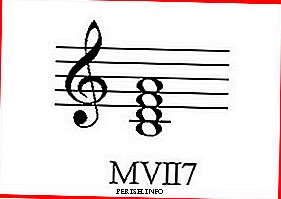
For a start, just remind you that a seventh chord is a chord (i.e., consonance) in which four sounds and these four sounds can be arranged in third. If you write a seventh chord with notes, then this recording will look like a drawn snowman, only circles (notes) will not be three, but four things.
Now, about where the nickname "introductory seventh chords" came from. The fact is that septa chords, like triads, can be built absolutely at any level of major or minor - at the first, at the second or third, at the sixth or at the seventh. You have probably already dealt with a dominant septa chord - this is a seventh chord, built on the fifth step. Perhaps you also know the second stage seventh chord.
So, introductory seventh chord - This seventh chord, which is built on the seventh step. The seventh step, if you remember, is called introductoryIt is the most unstable, located at a semitone distance relative to the tonic. Such an introductory function of this stage extended its effect to the chord that is built on this stage.
Once again, introductory seventh chords are seventh chords that are built on the introductory seventh step. These chords are composed of four sounds that are separated from each other at a distance of the third third.
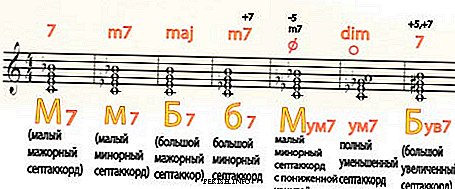
What are the introductory seventh chords?
They are two kinds - small and diminished. A small introductory seventh chord is built on the seventh degree of natural major, and only. A diminished introductory seventh chord can be constructed in harmonic modes - harmonic major and harmonic minor.
One of these two types of chords will be conditionally denoted as - MVII7 (small introductory or small reduced), and the other way - MindVII7 (reduced). These two chords differ in their interval compositionbut the basis of each of them is diminished triad.
Small reducedOr in other words, a small introductory seventh chord consists of two small third lines (i.e., a reduced triad), over which another third, but already a large one, is completed. Between the extreme sounds of this seventh chord a small septim interval forms..
Reduced introductory seventh chordor, as it is sometimes said, simply reduced consists of three minor third. It is possible to decompose them as follows: two small (that is, actually reduced triad at the base) and over them one more minor. Between the extreme sounds of this seventh chord, an interval of reduced septima is formed.
Take a look at this music example:

What kind of treatment does introductory seventh chords have?
Absolutely any seventh chord has three appeals, they are always the same name. it quintex chord (identification mark - tsiferki 65), tercquartcord chord (learn by numbers 43 right) and second chord (denoted by two - 2). Where these strange names come from, you can find out if you read the article "Structure of Chords and Their Names." By the way, remember that triad appeals (three-chord chords) are only two?
So, both small introductory and reduced introductory chords have three hits, which are obtained because each time we lower chord sound is transferable up to octaveor vice versa move the upper sound an octave down.
Let's deal with the interval structure of each chord resulting from the treatment:
- МVII7 = m3 + m3 + b3
- MVII65 = m3 + b3 + b2
- MVII43 = b3 + b2 + m3
- MVII = b2 + m3 + b3
An example of all these chords in the key in C major:

Small introductory seventh chord and its treatment in the key in C major
- UmmVII7 = m3 + m3 + m3
- UmmVII65 = m3 + m3 + u2
- UmVII43 = m3 + u2 + m3
- UmmVII2 = u2 + m3 + m3
Note example of all these chords in the key in C minor (in C major there will be the same sounds, only C-baker will be an ordinary C-note without additional icons):

Reduced introductory seventh chord and its treatment in key in C minor
With the help of the given music examples, you yourself can easily calculate at what levels each of the chords is built. So if seventh stage seventh chord in its main formnaturally you need to build at stage VII (only in a minor it will be VII raised). The first appeal - quintsekstakkord, or VII65 - will be located at stage II. Bass seventh-stage quartcord chord, VII43 is in all cases Stage IV, and the basis of the third appeal - second chord, VII2 - will be VI step (in major, if we need a smaller version of the chord, then we should lower this sixth step).
Allow introductory septa chords to tonic
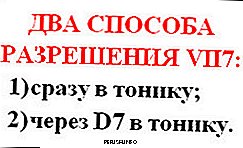 Introductory seventh chords can be resolved in tonic in two ways. One of them is to immediately translate these unstable consonances into tonic ones. That is, in other words, the execution direct resolution to tonic. With this method, the tonic at the end it turns out not quite normal, but more on that later. What is another way to resolve?
Introductory seventh chords can be resolved in tonic in two ways. One of them is to immediately translate these unstable consonances into tonic ones. That is, in other words, the execution direct resolution to tonic. With this method, the tonic at the end it turns out not quite normal, but more on that later. What is another way to resolve?
Another way is based on the fact that introductory seventh chords or their appeals do not immediately turn into tonic, but through a certain conductor - some "auxiliary" chord. AND in the role of such a conductor are appeals dominant septakorda. And only then this dominant septa chord (or some of its appeals) is allowed in tonic by all the rules.
Chord-conductor is selected on the principle: one that is built on the same step as the resolved chord, or one that is very close. The construction of introductory chords is possible on all unstable steps (VII7 builds on, VII - VII65, IV - VII43, and VI - VII2). At the same steps, except for one of the four - sixth steps, the dominant septas are constructed: at the seventh step, you can write D65, at the second - D43 and at the IV - D2. But for stage VI, you will have to use the dominant seventh chord itself in its basic form - D7, which is built on the fifth step, that is, it is one step below the allowed introductory second chord.
We look at the musical illustration (example with resolution):
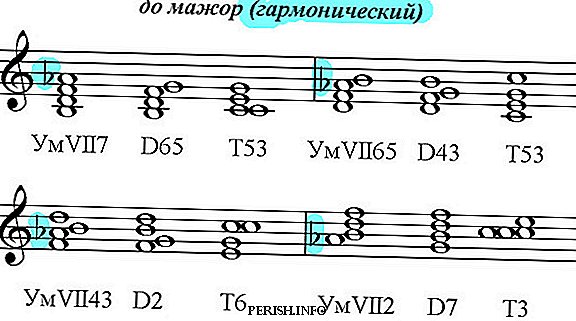
Resolution of the introductory seventh chord and its appeals through dominant harmonies in harmonic in C major
To quickly figure out which dominant chord to put after the introductory chord, they decided to use the so-called "wheel rule". According to the wheel rule, to resolve an introductory septum, the first treatment of the dominant septum is taken, for the resolution of the first circulation of the initial treatment, the second circulation is dominant, for the second introduction, the third dominant treatment, etc. You can portray it clearly - it will be clearer. Draw a wheel, place on its four sides the designation of appeals of the seventh chords in the form of numbers and find the subsequent chords, moving clockwise.
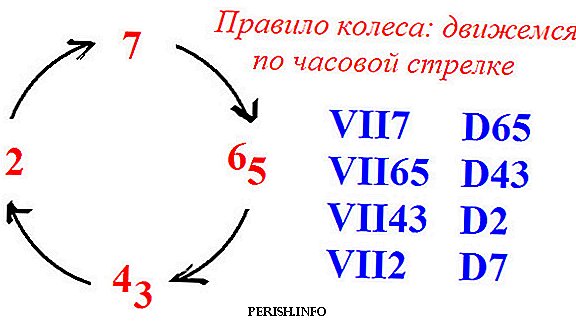
Now let's return to the method of resolving the introductory seventh chords stated earlier. We will translate these indefatigables into tonic immediately. Since there are four sounds in the seventh chord, and three sounds in the tonic triad, then with the resolution any of the triad sounds will simply be doubled. This is where the fun begins. Doubling in the tonic triad will be non-normative. What does it mean? The fact is that usually in the tonic triad the prima doubles - the main, most stable tone, tonic. And here the third will double - the third step. And this is not a whim. There are reasons for everything. In particular, the correct resolution will be of great importance in the direct transition to a tonic of a reduced intro chord, which includes two whole tritons, they must be properly resolved.
Another interesting point. Not any reversal of introductory septs will be resolved exactly into a triad.. Quinsextakcord and tertsquartkord, for example, will go to the sekstakkord with a double third (with doubled bass), and a second chord to the tonic quarteksektakkord, and only the introductory in the main form deigns to go into triad.
An example of resolution directly into the tonic:
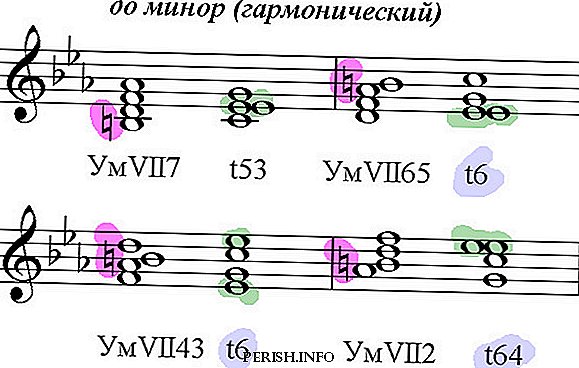
Allowing reduced introductory seventh chord and its conversions to tonic in harmonic to minor
Brief conclusions, but not the end
The whole point of this post in a nutshell. Introductory seventh chords are built on stage VII. There are two kinds of these chords - a small one, which occurs in natural major, and a smaller one, which manifests itself in harmonic major and harmonic minor. The introductory seventh chords, like any other seventh chords, have 4 reversals. There are two types of resolution of these harmonies:
- directly into the tonic with non-standard doublings;
- through chords dominant seventh chord.
Another example, introductory seventh chords in D major and D minor:
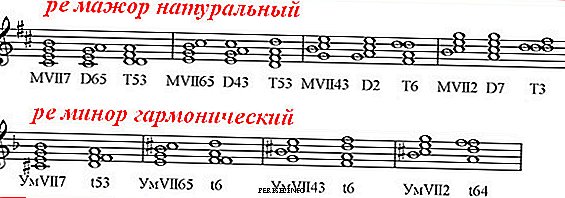
If you need to build on sound
If you want to build introductory seventh chords or any of their appeals from a particular given sound, then you will have to focus on the interval composition. Anyone who knows how to build intervals, build this without any problems. The main question that needs to be solved is the definition of tonality and the resolution of your construction in it.
Small introductory we allow only in major, and reduced - both in major and minor (with the key of the same name - for example, in C major and C minor, or G major and G minor). How to find out exactly what kind of tonality? Very simple: you just need to consider the sound from which you are building, as one of the steps of the sought tonality:
- If you have built VII7, then your lower sound will turn out to be a correspondingly VII step, and, stepping another step up, you will immediately get tonic;
- If it was necessary to write VII65, which, as you know, is built on stage II, then the tonic will be located, on the contrary, one step lower;
- If the specified chord is VII43, and it takes the IV step, then the tonic can be obtained by counting down four steps;
- Finally, if in your music notebook VII2 on the sixth step, then in order to find the first step, that is to say tonic, you need to go up three steps.
Having defined tonality in such a simple way, you will not have any troubles with resolution. You can perform the resolution in either of two ways - which one do you like more, if, of course, the task itself does not limit you in choosing.
Examples of introductory and their references from notes to and re:

Good luck with your business!

Leave Your Comment